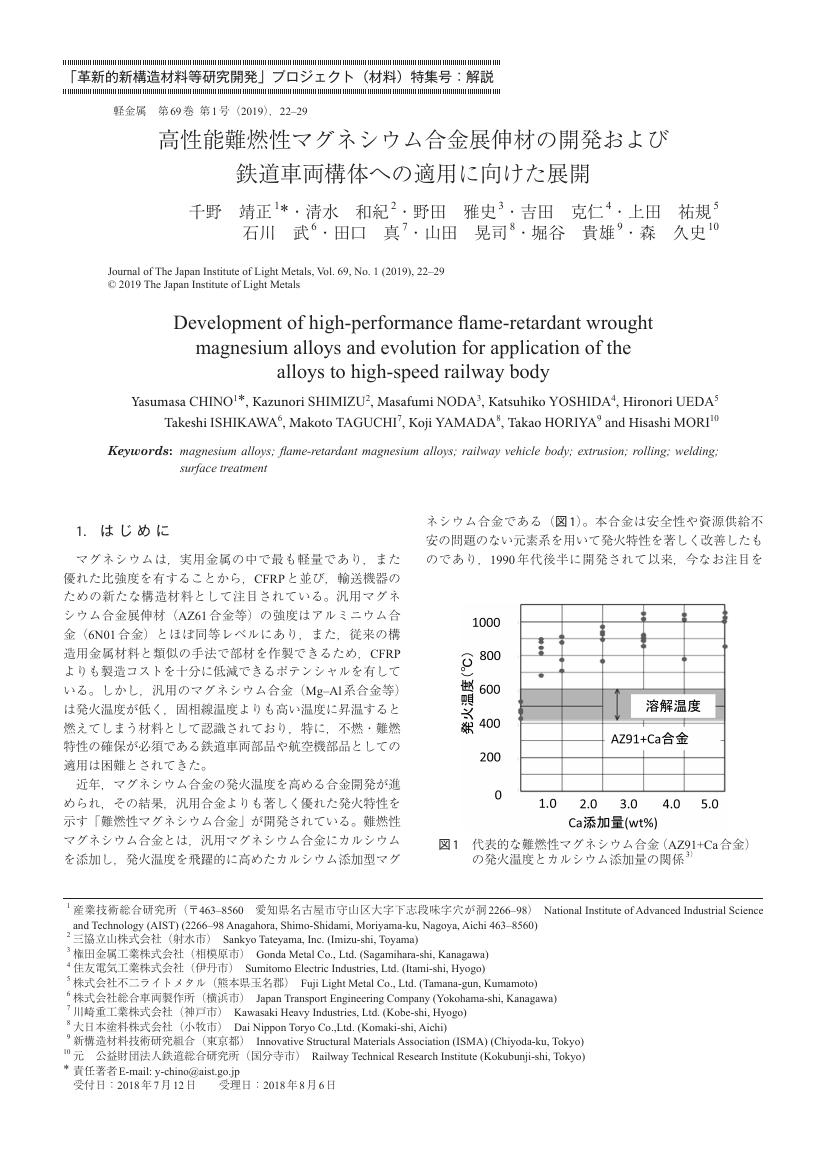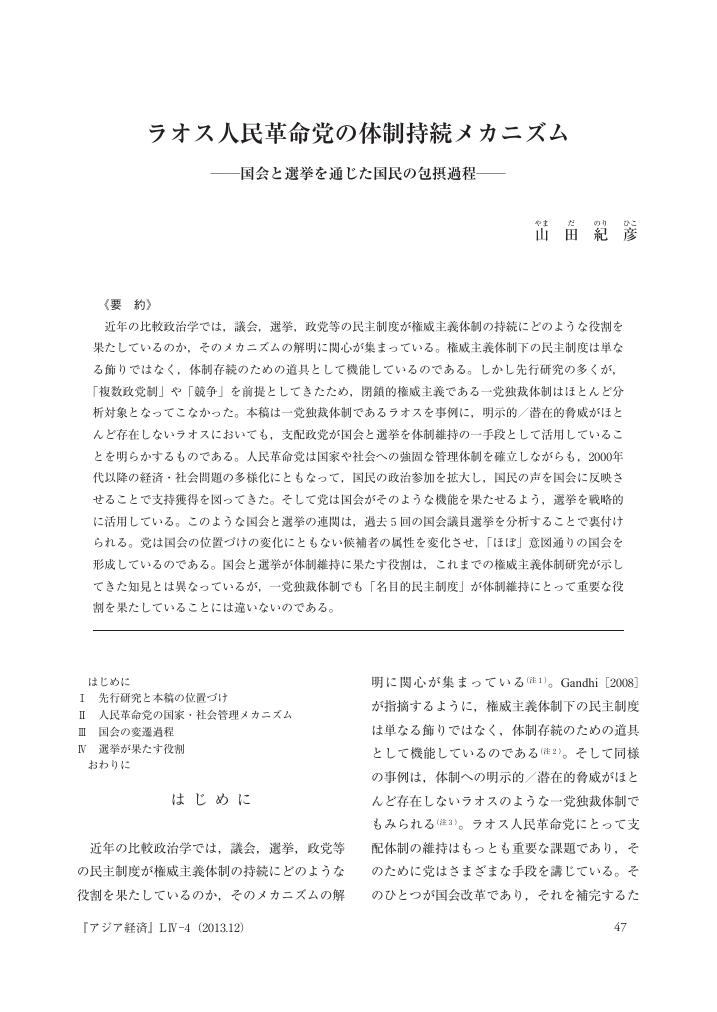- 著者
- 田辺 建二 山田 忠史 谷口 栄一
- 出版者
- Japan Society of Civil Engineers
- 雑誌
- 土木計画学研究・論文集 (ISSN:09134034)
- 巻号頁・発行日
- vol.25, pp.431-439, 2008-09-30 (Released:2010-06-04)
- 参考文献数
- 27
商品のサプライチェーン全体で生じる現象を記述するモデルとして, サプライチェーンネットワーク均衡 (SCNE) モデルに注目し, 製造業者・卸売業者・小売業者・消費市場の4主体で構成されるSCNEモデルの定式化を示し, モデルの性能の妥当性を検討した. モデルを用いて, 仮想ネットワークに対して, 都市内配送効率化や流入規制などの物流施策の効果を比較分析した. また, 複数の流通段階の利用が可能なSCINEモデルを用いて, 複数の流通段階をもつサプライチェーンネットワークの特性について, 輸送費用やEコマースとの関係の観点から基礎的な評価検討を行った. その結果, 物流施策の影響は施策実施箇所のみならず, SCN全体に波及する可能性が示唆された.
2 0 0 0 OA 商物分離型サプライチェーンネットワーク均衡モデル:異なるネットワーク形態の比較分析
- 著者
- 山田 忠史 中村 昂雅 谷口 栄一
- 出版者
- 公益社団法人 土木学会
- 雑誌
- 土木学会論文集D3(土木計画学) (ISSN:21856540)
- 巻号頁・発行日
- vol.67, no.5, pp.67_I_801-67_I_811, 2011 (Released:2012-12-28)
- 参考文献数
- 29
本研究は,既存の商物一体型モデルを基にして,サプライチェーンネットワーク上の各主体(製造業者,卸売業者,小売業者,消費市場,物流業者)の分権的な意思決定や行動の相互作用を考慮した,商物分離型のサプライチェーンネットワーク均衡モデルを提案し,各主体の意思決定の定式化やサプライチェーンネットワーク全体の均衡条件を示す.また,比較対象の一つとして,卸売業者が介在せず,流通段階が削減された場合のサプライチェーンネットワークについても,均衡モデルの枠組みで定式化を行う.これらのモデルを用いて簡単な数値計算を行うことにより,流通形態の相違がもたらす,物資流動量(商品取引量,生産量,輸送量)やサプライチェーンネットワークの効率性の変化について,基礎的検討を行う.
2 0 0 0 OA イランの水資源を取り巻く課題について
- 著者
- 山田 拓也
- 出版者
- 水文・水資源学会
- 雑誌
- 水文・水資源学会誌 (ISSN:09151389)
- 巻号頁・発行日
- vol.32, no.5, pp.255-262, 2019-09-05 (Released:2019-10-08)
- 参考文献数
- 1
イラン・イスラム共和国は中東の乾燥地帯及び半乾燥地域に位置している.1968年以降の降水統計を見ると,イラン全国の年平均降水量の過去50年間平均は,約248 mmである.しかしながら,年平均降水量は減少傾向を示しており,年平均降水量の近10年平均は約220 mmと,11 %程度減少している.これに伴い利用可能な水資源量も減少傾向にある.一方人口は増加の一途をたどり,1950年頃には3,000万人を下回っていた人口が2019年現在では約8,000万人を上回っている.加えて,都市化の進展や農業活動の活発化などにより水需要は著しく高まり,年間の水資源量のうち86 %を人間活動で使用しているなど,高度の水ストレス状態となっている.この結果,国内の様々な地域において恒常河川が間欠河川へと変化し,また社会活動における水の不足を補うために地下水位が継続的に低下している.このように,イランにおける水資源の管理に関する問題は,将来的なイランの社会経済活動の安定性や持続可能性に関わる非常に重要な問題となっている.本稿では,このようなイランの水資源管理が抱える課題について述べる.
- 著者
- 山田 康弘
- 雑誌
- 学術変革領域研究(A)
- 巻号頁・発行日
- 2023-04-01
2 0 0 0 OA 高性能難燃性マグネシウム合金展伸材の開発および鉄道車両構体への適用に向けた展開
2 0 0 0 OA ラオス人民革命党の体制持続メカニズム――国会と選挙を通じた国民の包摂過程――
- 著者
- 山田 紀彦
- 出版者
- 独立行政法人 日本貿易振興機構アジア経済研究所
- 雑誌
- アジア経済 (ISSN:00022942)
- 巻号頁・発行日
- vol.54, no.4, pp.47-84,202, 2013-12-15 (Released:2022-09-07)
- 被引用文献数
- 1
2 0 0 0 OA 失われた沖縄の文化「ハジチ(針突)」記憶の継承
- 著者
- 山田 豊
- 出版者
- デジタルアーカイブ学会
- 雑誌
- デジタルアーカイブ学会誌 (ISSN:24329762)
- 巻号頁・発行日
- vol.7, no.3, pp.129-133, 2023-08-01 (Released:2023-10-11)
- 参考文献数
- 19
女性の手にイレズミを施し、それが、『女性のあこがれの象徴』だった。そんな普通の日々が、ある日を境に、180°逆転し、悪と化してしまった。入れているものは警察に検挙され、入れていることに恥ずかしさを感じるようになった。1899年(明治32年)に禁止令が発令され、沖縄の女性の手からハジチが消滅した。その沖縄の失われた文化について、デジタルアーカイブの必要性を考える。
2 0 0 0 OA FRP掃海艇の実現に向けて : 開発経緯とその技術(<特集>FRP利用技術の新展開)
- 著者
- 山田 直樹
- 出版者
- 公益社団法人 日本船舶海洋工学会
- 雑誌
- 日本船舶海洋工学会誌 KANRIN(咸臨) (ISSN:18803725)
- 巻号頁・発行日
- vol.26, pp.21-26, 2009-09-10 (Released:2018-03-30)
2 0 0 0 OA カキ新品種‘太秋’
- 著者
- 山根 弘康 山田 昌彦 栗原 昭夫
- 出版者
- 農林水産省果樹試験場
- 巻号頁・発行日
- no.35, pp.57-73, 2001 (Released:2011-03-05)
2 0 0 0 OA 抗痴呆薬ドネペジルの経済評価
- 著者
- 池田 俊也 山田 ゆかり 池上 直己
- 出版者
- 公益財団法人 医療科学研究所
- 雑誌
- 医療と社会 (ISSN:09169202)
- 巻号頁・発行日
- vol.10, no.3, pp.27-38, 2000-12-15 (Released:2012-11-27)
- 参考文献数
- 31
- 被引用文献数
- 3 2
抗痴呆薬ドネペジルの経済的価値を評緬するため,マルコフモデルを用いて,軽度・中等度アルツハイマー型痴呆患者に対するドネペジル治療の費用-効果分析を実施した。分析の立場は支払い者の立場とし,費用は診療報酬点数および介護保険における在宅の給付限度額を参考に推計した。薬剤の有効性データは国内臨床第III相試験の成績を基にしたが,わが国における自然予後のデータは入手できなかったため米国の疫学データを用いた。薬剤の有効性,自然予後ならびに各病態における平均QOLスコアを組み合わせて質調整生存年(QALY)を算出し, 効果指標とした。2年間を時間地平とした分析では,軽度・中等度アルッハイマー型痴呆患者に対するドネペジルの投与により,既存治療に比べて患者の健康結果が向上するとともに,医療・介護費用が節減されることが明らかとなった。但し,ドネペジルの長期的効果やわが国におけるアルッハイマー型痴呆患者の予後に関するデータが不充分であることから,今後,これらのデータが蓄積された際には本分析結果の再評価を行うことが望ましいと考えられる。
2 0 0 0 Deep Learningを用いたデザインAIの作成と検証
- 著者
- 山田 悟史 大野 耕太郎
- 出版者
- 日本建築学会
- 雑誌
- 日本建築学会計画系論文集 (ISSN:13404210)
- 巻号頁・発行日
- vol.85, no.770, pp.987-995, 2020 (Released:2020-04-30)
- 参考文献数
- 27
- 被引用文献数
- 1
In recent years, there has been a growing interest in the application of Deep Learning to architecture and urbanism. This research is focused on content generation AI using Deep Learning. Despite claims that replacing creativity-related work with machines is difficult, the use of generative adversarial networks (GANs) is becoming more popular in various fields. The objective of this research is to develop an AI-supported design or a co-creation between humans and AI through the application of GANs. The primary goal of this work could be interpreted as repurposing existing concepts to create new designs through the combination of multiple design sources. Therefore, the purpose of this research is the creation of AI that emulate and support the design process. This research examines two types of AI through a two-stage process; the first is an AI that reproduces design, and the second is an AI that generates design. The first type of AI reproduces designs from different sources and includes an analysis of whether the design can be expressed mathematically. This analysis is a prerequisite for the creation of the second type of AI that generates new designs by combining information from multiple sources. In other words, the second type of AI views designs mathematically, and the possibility of expressing designs mathematically (using the first type of AI) is examined to ensure that such a function is feasible and in line with user intention. Here, a mathematical expression refers to a 100-dimensional vector and an already-learned deep neural network. The AI that reproduces design was applied to famous cityscapes (Kyoto and Edinburgh) and the façades of famous buildings (three works by Le Corbusier). The designs were reproduced as images and used for subject experiments to confirm that the intended impressions (oriental and occidental) and the designs of each type were successfully reproduced. For the AI that generates design, a new design was generated from calculations of different combinations (three pairs and one trio) of the façades of three works by Le Corbusier (church of Saint-Pierre, Notre Dame du Haut, and Villa Savoye). This design was subsequently used for text mining Bayesian-estimation-based subject experiments to confirm that the characteristics of the design sources were successfully inherited. To the best of our knowledge, these are new types of AI. Further, we believe that these achievements may facilitate better dissemination of design through fast generation of a large number of images (design patterns) that constitute new types of designs. This achievement may also help expand the concept of human design thinking by suggesting designs that can be permuted using AI but otherwise inconceivable for human designers. Ultimately, this can help in the creation of a new design environment, namely “co-creation between humans and AI,” wherein the designers choose the sources and the AI generates a number of design choices for the final design.
2 0 0 0 OA 現代社会における子育ての「意味」の危機
- 著者
- 山田 昌弘
- 出版者
- 日本家族社会学会
- 雑誌
- 家族社会学研究 (ISSN:0916328X)
- 巻号頁・発行日
- vol.11, no.11, pp.49-57, 1999-07-31 (Released:2009-08-04)
- 参考文献数
- 14
今、家族社会学者は、「なぜ親は子どもを育てるか」という問いにとりくまなくてはならない。ヘーゲルは、近代社会における子育ての原型を論じた。彼は、親子関係が子の成人後に消滅するということを強調し、近代的子育ての二つの性格を導いた。一つは、親はもう子育てに、経済的効用を見出すことができないため、意味を見出すことが求められ、子育ての主要な動機付けは、愛情になるということである。もう一点は、親子の愛が未完成であるということで、その結果、親は、愛情の存在を信じることができた。近年の長寿化と「学校化」によって、親にとって子育ての意味付与の危機がもたらされる。親子関係に愛情があると確信するためには、成人後の子や学校システムなど公共からの評価が必要になるからである。その結果、親は、子育てにプレッシャーを感じることが多くなる。それゆえに、親は、なぜ子どもを育てるのかという問いに悩まされるようになる。
2 0 0 0 OA 歯根部に侵襲性の外部吸収を生じた下顎犬歯を外科的に修復した症例
- 著者
- 田宮 資己 山田 雅司 番場 桃子 井瀬 智之 佐古 亮 古澤 成博
- 出版者
- 一般社団法人 日本歯内療法学会
- 雑誌
- 日本歯内療法学会雑誌 (ISSN:13478672)
- 巻号頁・発行日
- vol.43, no.1, pp.37-40, 2022 (Released:2022-02-15)
- 参考文献数
- 9
Abstract : There are different classifications of external root resorption. As Heithersay GS reported, treatment for invasive cervical resorption becomes difficult once the resorption reaches the apical portion. In the present case report, root resorption that continued from the root area of the lower right canine into the root canal was observed by CBCT. It was diagnosed as invasive resorption accompanying periodontitis. Regular root canal treatment, with rubber-dam and sufficient irrigation followed by obturation, was performed. After root canal obturation, a flap was opened under a microscope, followed by curettage of the granulation tissue of the resorption area from the periodontal ligament side. Then, MTA was used to seal the resorption area. At one-year follow-up, there was no tenderness, pus from periodontal pockets or any other symptoms. It is considered that the removal of granulation tissue and separation of the root canal from the periodontal pocket with MTA filling is effective for the treatment of invasive resorption.
2 0 0 0 心理学研究における構造方程式モデリング(SEM)の応用のあり方
- 著者
- .企画代表者(Representative Organizer)伊藤 大幸 .話題提供者(Speaker)伊藤 大幸 .谷 伊織 .村上 隆 .指定討論者(Discussant)山田 剛史 .司会者(Chair)伊藤 大幸
- 雑誌
- 日本心理学会第87回大会
- 巻号頁・発行日
- 2023-08-03
2 0 0 0 OA 選好の理由の言語化が選好に与える影響
- 著者
- 山田 歩
- 出版者
- 公益社団法人 日本心理学会
- 雑誌
- 日本心理学会大会発表論文集 日本心理学会第72回大会 (ISSN:24337609)
- 巻号頁・発行日
- pp.1AM132, 2008-09-19 (Released:2018-09-29)
2 0 0 0 OA 原始的なカメムシ亜目昆虫の謎めいた交尾器を探る:形態進化と多様化プロセスの解明
- 著者
- 山田 量崇 Weirauch Christiane 蔡 經甫
- 出版者
- 徳島県立博物館
- 雑誌
- 基盤研究(C)
- 巻号頁・発行日
- 2016-04-01
ムクゲカメムシ下目の主要3科(ムクゲカメムシ科、オオムクゲカメムシ科、ノミカメムシ科)に対し、飼育実験系を確立し、交尾行動の観察を行った。3科ともメスの右側方からオスの腹部が挿入されて接合するオス上位の姿勢が観察された。ムクゲカメムシ科の交尾ペアの形態観察から、オスの腹部付属片の機能について検証した。第3~8腹節の付属片(側背板)がメスの腹部後方を背腹面に挟むように把握することがわかった。メス側には、把握される部位(背板の一部)がやや厚くなるなどの形態の変化が見られた。科ごとにオスの腹部第8側背板の機能が異なっていた。
2 0 0 0 OA 稀な病変を有した悪性リンパ腫合併シェーグレン症候群の剖検2症例
- 著者
- 永渕 裕子 伊藤 彦 小泉 宏隆 風間 暁男 高木 正之 山田 秀裕 尾崎 承一
- 出版者
- 一般社団法人 日本臨床リウマチ学会
- 雑誌
- 臨床リウマチ (ISSN:09148760)
- 巻号頁・発行日
- vol.28, no.1, pp.75-81, 2016-03-30 (Released:2016-05-31)
- 参考文献数
- 13
子宮腫瘍と両側副腎腫瘍を呈した悪性リンパ腫(ML)合併シェーグレン症候群(SjS)の2剖検例を経験した.症例1:関節リウマチとSjS合併の83歳女性.下腿浮腫精査で子宮腫瘍を指摘.症例2:SjSの83歳男性.発熱精査で両側副腎腫瘍を指摘.2例共生検できず.剖検でびまん性大細胞型B細胞性リンパ腫の診断が確定した.MLによる子宮と副腎病変は稀で,SjSでの報告はない.SjSに合併する腫瘍の鑑別として重要と考え,報告する.
2 0 0 0 OA がん疼痛治療中の高度便秘にエリスロマイシンが著効を示した1症例
- 著者
- 渡邊 法男 山田 卓也 吉田 知佳子 細川 佐智子 中川 千草 安村 幹央 山村 恵子
- 出版者
- 一般社団法人 日本プライマリ・ケア連合学会
- 雑誌
- 日本プライマリ・ケア連合学会誌 (ISSN:21852928)
- 巻号頁・発行日
- vol.39, no.1, pp.40-42, 2016 (Released:2016-03-25)
- 参考文献数
- 8
- 被引用文献数
- 1 1
症例は40代男性, 原発不明がん, 肺転移, 脊椎転移 (T5-6) . モルヒネ硫酸塩徐放錠, ナブメトン錠, アミトリプチリン塩酸塩錠で疼痛治療中に, 腫瘍の進展に伴う脊髄圧迫部位以下の麻痺が完成し, 同時期から, 高度の腹部膨満感, 便秘を認めた. 各種腸管蠕動亢進薬を使用したが症状は改善しなかった. そこで, モチリン受容体アゴニストとして, 自律神経系の麻痺による消化管運動障害改善効果が報告されているエリスロマイシン点滴静注 (1回500mg, 3回/日) を開始したところ, 症状が著明に改善した. その後, エリスロマイシン錠 (1回200mg, 3回/日) へ変更し, 良好な排便コントロールを得ることができた. エリスロマイシンは, 各種腸管蠕動亢進薬が無効な腫瘍の脊髄圧迫など麻痺性の消化管運動障害による便秘に対し有用な治療薬の一つであると考える.
2 0 0 0 OA 非円形プーリ–バネ系による自重補償機構と4節平行リンク型アームへの適用
- 著者
- 遠藤 玄 山田 浩也 矢島 明 尾形 勝 広瀬 茂男
- 出版者
- 一般社団法人 日本ロボット学会
- 雑誌
- 日本ロボット学会誌 (ISSN:02891824)
- 巻号頁・発行日
- vol.28, no.1, pp.77-84, 2010 (Released:2012-01-25)
- 参考文献数
- 10
- 被引用文献数
- 9 8
We propose a new weight compensation mechanism with a non-circular pulley and a spring. We show the basic principle and numerical design method to derive the shape of the non-circular pulley. After demonstration of the weight compensation for an inverted/ordinary pendulum system, we extend the same mechanism to a parallel four-bar linkage system, analyzing the required torques with transposed Jacobian matrices. Finally, we develop a 3 D.O.F manipulator with relatively small output actuators and verify that the weight compensation mechanism greatly contributes to decrease static torques to keep the same posture within manipulator's work space.
2 0 0 0 OA 風水害における消防団員の人的被害の特徴 -1969年から2018年までの災害を事例に-
- 著者
- 山田 忠 後藤 雄太 松枝 心路
- 出版者
- 公益社団法人 土木学会
- 雑誌
- 土木学会論文集F6(安全問題) (ISSN:21856621)
- 巻号頁・発行日
- vol.76, no.1, pp.20-27, 2020 (Released:2020-08-20)
- 参考文献数
- 78
- 被引用文献数
- 1 1
本報告は消防団が今後の風水害活動で注意すべき事項について検討することを目的に行った.具体的には,消防団員が殉職した1969年から2018年の風水害の事例を消防白書や新聞記事,既往研究などから把握し,殉職時の状況を分析した. 結果として,消防団が今後の風水害活動で注意すべき3点を示した.1点目に,風水害は出動途上から帰宅中までの一連の活動において殉職者が出ており,一連の活動で安全に配慮する必要がある.2点目に,河川を中心に夜間の強い雨が観測されているときに殉職者が多い傾向にあり,夜間で雨が強い場合は活動しない,もしくは団員の安全が確保できた状態で活動に取り組む必要がある.3点目に,昼間で雨のピークが過ぎた後の活動でも殉職者が出ており,昼間で雨が弱くなっても周囲の状況に細心の注意を払って活動する必要がある.



